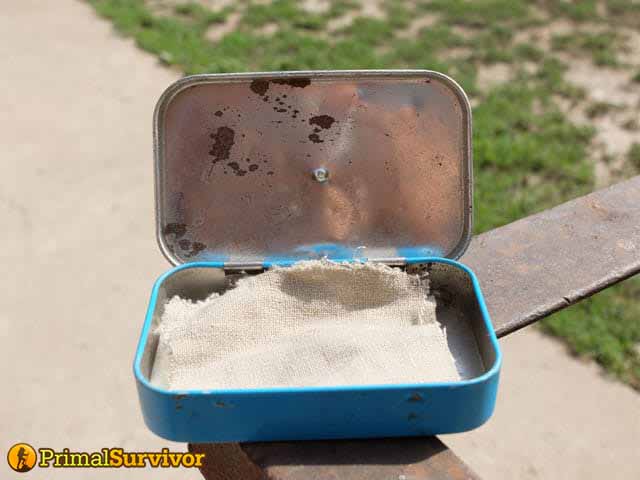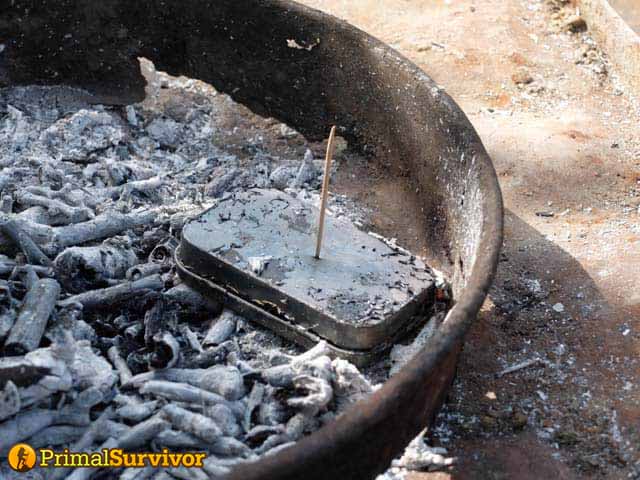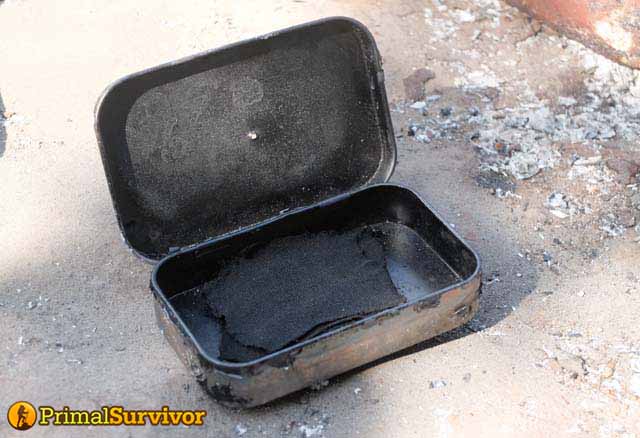Any outdoors person knows the value of good tinder. You won’t get a fire going without dry, combustible tinder, even with matches or a lighter. Arguably, the very best tinder for fire starting is a char cloth.
Making char cloth is pretty simple, but some issues can arise.
We’ll discuss how to make char cloth and troubleshoot these issues here.
What Is a Char Cloth?
Char cloth is a cloth that has been turned into charcoal. The char cloth ignites at low temperatures, which makes lighting it with sparks easier.
The scientific term for making char cloth is pyrolysis. You can read all about the science of it here. In simple terms, it involves heating a natural plant material in an anaerobic (without oxygen) environment.
You can often get a char cloth lit with just one spark! You then use it to light other tinder. If you are trying to make a fire with a Ferro rod or flint and steel, a char cloth will make your life much easier – or possibly save your life in a survival situation.
*Realistically, you probably won’t use a char cloth for survival. I always bring survival lighters when I go backpacking in the wilderness.
However, building a fire using a char cloth and F&S (flint and steel) is a lot of fun.
DIY Instructions
To make char cloth, you need to put a cloth made from natural material in a sealed, fireproof container. You then put the container on flames or coals.
Because the container is sealed, hot air inside the container will build up and exit the container. Thus, the cloth gets heated in the absence of oxygen.
1. Get a Fireproof Tin

Most people use an Altoids tin because they are so readily available. You can also use things like soda cans with tinfoil on top to seal it. Cookie tins or clean paint cans are good if you want to make larger amounts of char cloth at once.
Remember that people have been making char cloth for centuries – long before Altoids was around. The primitive way of charring a cloth involved wrapping plant materials in layers of green leaves. The plant material could also be buried in sand in a clay pot to cut off air.
Once you’ve mastered making a char cloth in a tin, it can be fun to experiment with making char cloths using primitive methods.
Tip:
When making large amounts of char cloth in larger tins, it helps burn off any paint/residue on the tin first. Otherwise, you won’t know if the residue is making smoke or the cloth.
2. Punch a Small Hole in the Tin
The tin allows smoke to escape the tin while making the char cloth. The hole needs to be small. Just a pinhole will do! Nothing larger than 1/8th of an inch.
*Some people like to put a hole in the top and bottom of the tin. This allows gases to escape better when you flip it (step 7).
3. Get Your Cloth
You must only use 100% natural plant-based cloth for making char cloth. Any synthetics in your cloth will stop sparks dead in their tracks. Wool also won’t work. Below, I’ll talk more about the best materials for char cloths.
I generally like to keep my cloths around 2×2 inches. Some people get up to 4×4 inches. The cloth will shrink a bit once it has been charred.
4. Put Cloth in the Tin
Don’t pack the cloth too tightly in the tin, whatever size you choose. It needs to be loose, or the cloth won’t char evenly.
5. Heat Your Tin

You now need to close the tin and put it on a heat source. The easiest method is to put it on a portable camping stove.
However, it can be a bit tricky to see the smoke escaping the tin through the flames of a camping stove (which you need to see to know when the char cloth is done). It’s also hard to flip a hot tin on a camp stove.
A better method is to build a fire and let it burn down to hot coals. Put the tin on the hot coals. You can also put it directly on a campfire, but you’ll have the same issue as with a campfire – you won’t be able to see smoking escaping well.
6. Watch for Smoke Coming from the Tin

Once your tin is on the fire, coals, or stove, it will cause the gases inside the tin to heat up. This creates a higher pressure system, and the gases will be pushed out of the tin through the hole you made.
Because the gases are escaping the tin, no air is allowed in. This is imperative: if oxygen gets into the tin, you won’t get char cloth!
As the gases escape, you will see smoke coming out of the hole in the tin. Pay attention! You might also see a flame shooting out of the hinges of your tin as the gases ignite.
7. Flip the Tin
Once smoke/flame stops coming out of the hole, you will need to flip the tin over. The reason for doing this is to make sure the cloth chars evenly. Otherwise, the bottom of the cloth gets more charred, and the top is undercooked.
When you flip the tin, you’ll probably see more smoke or a flame start coming out of the tin again. Once the smoke stops, remove the tin from the heat.
8. Remove the Tin from the Heat
You must remove the tin from the heat immediately after smoking has stopped (within 30 seconds of not seeing any more smoke).
If you leave it in the heat, there won’t be any more gases escaping the tin – which means air can enter it. Suddenly, your char cloth is exposed to oxygen and will be combusting instead of charring!
*When making char cloth on a bed of coals, it’s enough to push it off to the side. You don’t have to put it somewhere completely cool.
9. Plug the Hole

Many people plug the hole in the tin after removing it from the heat. The reason for doing this is to prevent oxygen from entering the tin.
Air can come rushing into the tin as it’s cooling, potentially ruining the char cloth. So, while not absolutely necessary, plugging the hole will usually get you more uniformly charred, better results.
How do you plug the hole or holes in the tin? You can use the same pin or nail you used to make the hole in the first place (though nails are hard to keep upright in the tin). Small sticks that have been whittled to a point usually work better. I used a toothpick in this demonstration.
*Instead of plugging the hole, you can bury the tin after removing it from the flames.
10. Let Tin Cool and Open

Wait until the tin has cooled before you open it. You should be able to handle it with your bare hands.
If you open it too early, oxygen can get to the cloth and cause it to combust. While this has never happened to me, I’ve heard of entire pieces of cloth bursting into flames when the tin was opened too early!
Even if the cloth doesn’t burst into flames, the oxygen could cause some of the surface area to combust. That limits the amount of useable char cloth you get – meaning that only parts of your char cloth will catch a spark.
Using a Char Cloth

A char cloth will not make a flame. Instead, it will catch a spark and create a small ember that slowly smolders. You can then use this ember to ignite tinder. The tinder lights kindling, which lights your fuelwood. And then you’ve got a fire!
To make a fire with a char cloth:
- Prepare a “bird’s nest” of tinder. Read this post on the best tinder.
- Use your Ferro rod or F&S to rain sparks on the char cloth. Read how to use a Ferro rod here.
- The char cloth should create a glowing ember.
- Put the glowing char cloth on your tinder nest.
- Blow so the char cloth ember transfers to the tinder and turns into a flame.
- Remove the char cloth and put it out so it can be used again.
- Keep feeding your flame and build yourself a fire!
It can be hard to see the spark burning on the char cloth – especially in the bright sun. You might feel it burning on your hand before you see it! 😮
Tips:
- Test your char cloth! Before you take char cloth in the field, you should test it. You don’t want to be in the wilderness when you discover it has failed.
- Practice makes perfect: Remember that matches and lighters were invented for a reason! If making a fire with a char cloth was easy, we’d still do it that way. It takes some practice to get a fire going with a char cloth – especially when the conditions (wind, rain, wet tinder…) aren’t in your favor!
Troubleshooting and FAQs
Making char cloth is a straightforward process. However, don’t feel bad if you have some issues. Here are some of people’s most common problems and questions with char cloths.
What should a char cloth look like?
When successfully made, a char cloth should be black all over. It should be soft, thin, and easy to tear. It almost has a velvety feel to it, like old flannel. You should be able to fold it, and it will keep its shape.
If there are still BROWN parts on the cloth, you didn’t cook the char cloth long enough. This is no big deal. Just restart the process with the same cloth.
The char cloth should NOT crumble or be ashy. It should not leave any soot on your fingers. This means that you overcooked it.
What cloth is best for making char cloth?
Char cloth should be made from 100% natural plant materials. 100% cotton fabrics are the most popular, but linen and jute work well. You can also use punk wood to make char cloth (though it won’t be a cloth).
Whatever material you use, it mustn’t have any synthetics or wool in it. It only takes a bit of synthetic to stop a spark dead in its tracks!
Also, ensure there isn’t any fabric softener left in the material.
Some good options for char cloth material include:
- 100% cotton Terry bath cloths (this is great because it has so much surface area!)
- Old cotton t-shirts
- Denim jeans (not the stretch kind)
- Cheesecloth
- Muslin
- Canvas
Tip:
Char cloths made from thin materials (like t-shirts) ignite easier than those made from thicker materials (like denim). The thinner material will burn faster, but it’s still better if you aren’t experienced using a F&S or Ferro rod.
How long should the char cloth cook?
It depends on how much cloth you use and how tightly you pack it. A loosely packed Altoids tin usually takes 5-10 minutes on one side and 2-5 minutes on the other. Don’t go by these numbers, though! You need to watch for the smoke to stop coming out.
Why isn’t my char cloth lighting?
There are several reasons your char cloth might not catch a spark and ignite. Here are some of the most common issues.
The wrong cloth was used.
Are you sure the cloth was 100% cotton (or jute or linen)? If there are any shiny areas in the cloth, that’s a sure sign of synthetics.
You overcooked the char cloth.
This is the most likely reason that the char cloth won’t light. If it spent too much time on the fire (or oxygen got to the cloth after it was removed from the fire), oxygen will get inside the tin and cause the cloth to combust.
To fix this, remake the char cloth with a fresh cloth. This time, make sure you REMOVE THE TIN when the smoke stops and PLUG THE HOLE. Don’t open the tin until it is COMPLETELY COOL.
If it’s still getting overcooked, you might have too much leakage in your tin. Make sure the tin seals tightly.
Remember, only uncombusted material will catch and hold a spark, so you’ve got to make sure no oxygen gets to the cloth.
You undercooked the char cloth.
It’s easier to spot undercooked char cloth than overcooked char cloth. Undercooked char cloth will have brown spots on it. These areas will not ignite or allow an ember to grow.
One reason for undercooking is that you packed the material too tightly. Try making it again but with less cloth in the tin. You can also try flipping the tin around so the cloth inside gets more exposed to the heat.
The cloth got wet.
Char cloth will not catch a spark when wet even when properly made. The humidity from the air can enter the container you use to hold the char cloth.
If you are still at home, it’s easy to test whether this is the reason your char cloth isn’t igniting. Just put it in the oven at very low heat for about 10-20 minutes. This will dry out the char cloth so it can catch a spark.
If this doesn’t work, then one of the other reasons is probably to blame.
The fabric weave is too tight.
This probably isn’t the issue, but sometimes it’s hard to catch a spark if the char cloth was made from fabric with a tight weave. You can try to fringe the edges of the char cloth to make them fluffier.
Flame retardants were added to the cloth.
Some shop cloths are treated to make them flame retardant. I doubt that this is the problem, but it is possible.
Some of my char cloth batches turn out great. Others barely catch a spark. What’s the deal?
A lot of people will blame this on the type of cloth used. However, the real issue is probably oxygen getting to your char cloth or part of the cloth.
If even part of the cloth gets combusted instead of charred, it won’t hold a spark. So, you will be able to ignite parts of the cloth, and the spark will peter out as it reaches the combusted parts.
You need to PLUG THE HOLE to get good, consistent results when making char cloth.
Do I have to poke a hole in the tin to make char cloth?
No – it is possible to make char cloth in a closed vessel. However, it’s much harder to tell when it is done cooking.
Also, if you use an Altoids tin and don’t poke a hole in it, the pressure from the hot gasses will cause the lid to open. You could push the lid down with a stick, but too much oxygen might have already reached the cloth.
How should I store my char cloth?
Keep your char cloth in an airtight tin. The reason for this is to prevent moisture from reaching it. Charred materials act like sponges and absorb water from the air, making them difficult to ignite.
If you used a mint tin to make your char cloth, you could store it in the same tin. Just use a piece of wax (from a melted candle) to plug the hole.
All images copyright www.Primalsurvivor.net



I would also like to recommend trying another source of tinder. Use lint from your clothes dryer filter. Like char cloth, use natural plant material…as cotton. But this is harder to make “in the field” than char cloth…it must be prepared ahead of time at home, and dry stored & taken with you to the field.
Yes, Dryer Lint is good, but it can be ‘AMPTED-UP’ by saturating it with wax, or even chapstick.
Which not only increases its flammability, but also helps resist dampness.
If using chapstick, you can form the now-infused lint into the same shape, and put it back into the chapstick holder from whence it came, thereby adding another tool to your EDC arsenal.
I actually made 29 different types of fire starters and tested them (wrote about it here https://www.primalsurvivor.net/diy-fire-starters/). Dryer lint + petroleum jelly is by far my favorite option. Dryer lint by itself doesn’t always light well since so much of our clothing is synthetic material which melts instead of burning.
Do you recommend having a hole on both sides of the tin, or will one on the top be sufficient?
One hole will usually be enough. But, if you are trying to make a lot of char cloth at once (like in a cookie tin versus a mint tin), then go with two holes.
Whatever you do, make sure gases can escape the container. If the container is too airtight, the expanding gases inside will cause the lid to pop off (perhaps even explosively) and your cloth will instantly catch fire. I have personally witnessed this while watching others attempt to char cloth. Gases produced inside the tin must be able to vent.